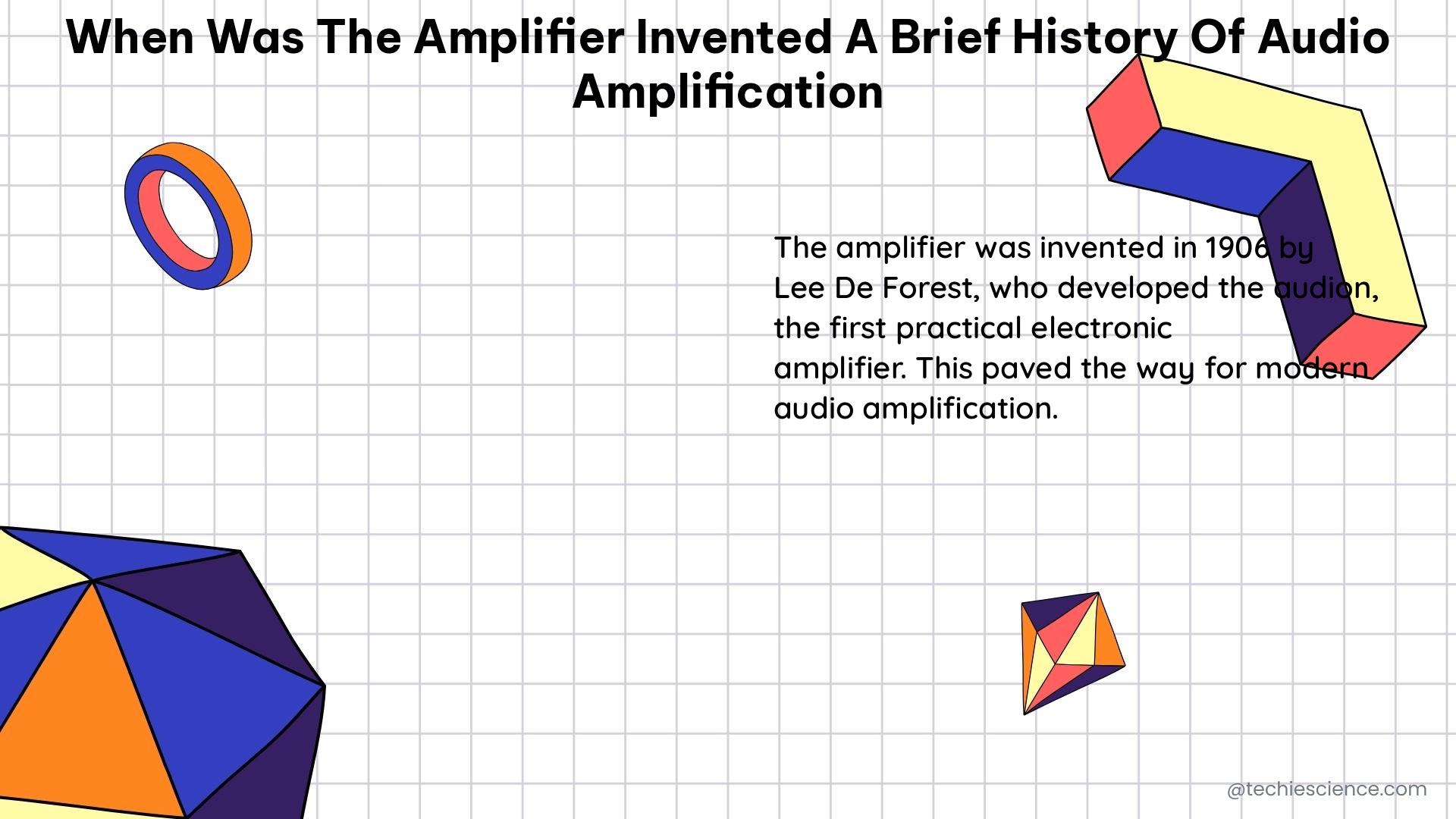The amplifier, as we know it today, has a rich history that dates back to the late 19th and early 20th centuries. The first practical audio amplifier was invented by Lee De Forest in 1906, who developed the Audion, a vacuum tube that could amplify electrical signals. This invention revolutionized the field of audio technology and paved the way for the development of various types of amplifiers used in different applications.
Vacuum Tube Era (1906-1950s)
The vacuum tube amplifier, invented by Lee De Forest, was the first practical audio amplifier. It was widely used in radio transmitters, public address systems, and early phonographs. The vacuum tube amplifier was later improved by several key figures:
- Harold Black: Invented the feedback amplifier in 1927, which significantly improved the stability and performance of vacuum tube amplifiers.
- Edwin Armstrong: Developed the regenerative and superheterodyne circuits, which were crucial for the development of radio technology.
Vacuum tube amplifiers had several key characteristics:
- Power Output: Typically had a higher power output compared to transistor and integrated circuit amplifiers, with some models reaching up to 100 watts or more.
- Efficiency: Less efficient than transistor and integrated circuit amplifiers, with typical efficiencies ranging from 20% to 50%.
- Heat Generation: Produced a significant amount of heat due to the high power consumption of vacuum tubes.
- Size and Weight: Larger and heavier than transistor and integrated circuit amplifiers, due to the size of the vacuum tubes and associated components.
Transistor Era (1950s-1960s)

The invention of the transistor in 1947 led to the development of the transistor amplifier, which was smaller, more efficient, and more reliable than the vacuum tube amplifier. The transistor amplifier was widely used in portable radios, guitar amplifiers, and public address systems.
Transistor amplifiers had the following key characteristics:
- Power Output: Typically had a lower power output compared to vacuum tube amplifiers, with most models ranging from 10 to 50 watts.
- Efficiency: More efficient than vacuum tube amplifiers, with typical efficiencies ranging from 50% to 80%.
- Heat Generation: Produced less heat than vacuum tube amplifiers due to their higher efficiency.
- Size and Weight: Significantly smaller and lighter than vacuum tube amplifiers, making them more portable and easier to integrate into various electronic devices.
Integrated Circuit Era (1960s-Present)
The invention of the integrated circuit in 1958 led to the development of the integrated circuit amplifier, which was even smaller, more efficient, and more reliable than the transistor amplifier. The integrated circuit amplifier is widely used in audio equipment today, including home stereos, car audio systems, and professional sound systems.
Integrated circuit amplifiers have the following key characteristics:
- Power Output: Typically have a lower power output compared to vacuum tube and transistor amplifiers, with most models ranging from 5 to 100 watts.
- Efficiency: The most efficient of the three types of amplifiers, with typical efficiencies ranging from 70% to 90%.
- Heat Generation: Produce the least amount of heat due to their high efficiency.
- Size and Weight: Extremely small and lightweight, allowing for easy integration into a wide range of electronic devices.
The development of audio amplification has been driven by several key factors, including the need for higher power, greater efficiency, and better sound quality. The evolution of audio amplification can be seen in the technical specifications of different types of amplifiers, with each generation offering improvements in size, weight, efficiency, and power output.
References:
- Verfaille, V., Holters, M., & Zölzer, U. (2011). Introduction. In DAFX—Digital Audio Effects, 2nd ed. John Wiley & Sons, Inc.: Chichester, UK.
- Mulder, J. (2015). Early history of amplified music: Transectorial innovation and decentralized development. In Proceedings of the Audio Engineering Society Conference: 59th International Conference on Sound Reinforcement Engineering and Technology, Montreal, QC, Canada.
- Richard C. Heyser (1931-1987), architect of time-delay spectrometry and founder of the modern school of mathematically-based audio measurements.

The lambdageeks.com Core SME Team is a group of experienced subject matter experts from diverse scientific and technical fields including Physics, Chemistry, Technology,Electronics & Electrical Engineering, Automotive, Mechanical Engineering. Our team collaborates to create high-quality, well-researched articles on a wide range of science and technology topics for the lambdageeks.com website.
All Our Senior SME are having more than 7 Years of experience in the respective fields . They are either Working Industry Professionals or assocaited With different Universities. Refer Our Authors Page to get to know About our Core SMEs.